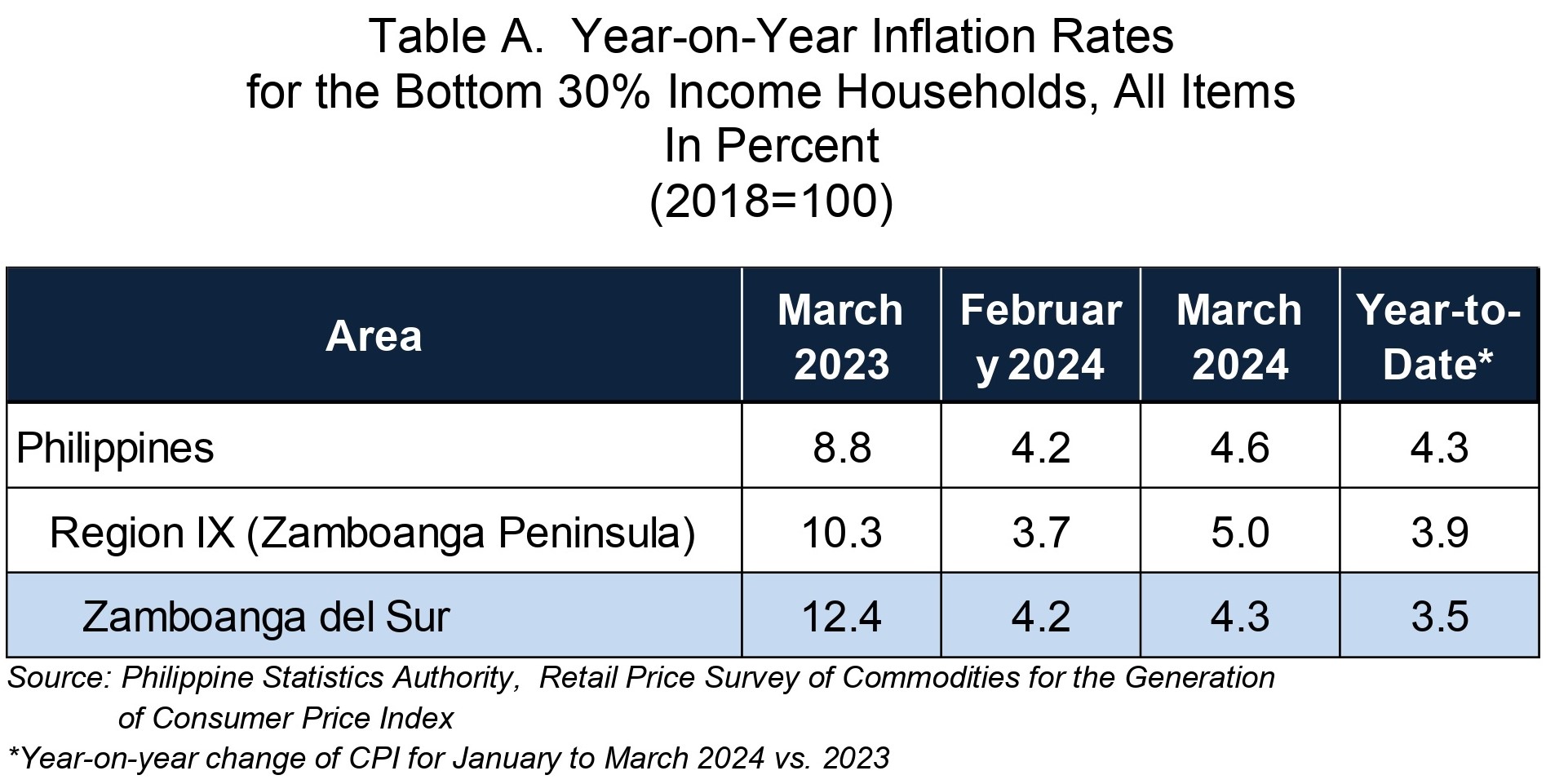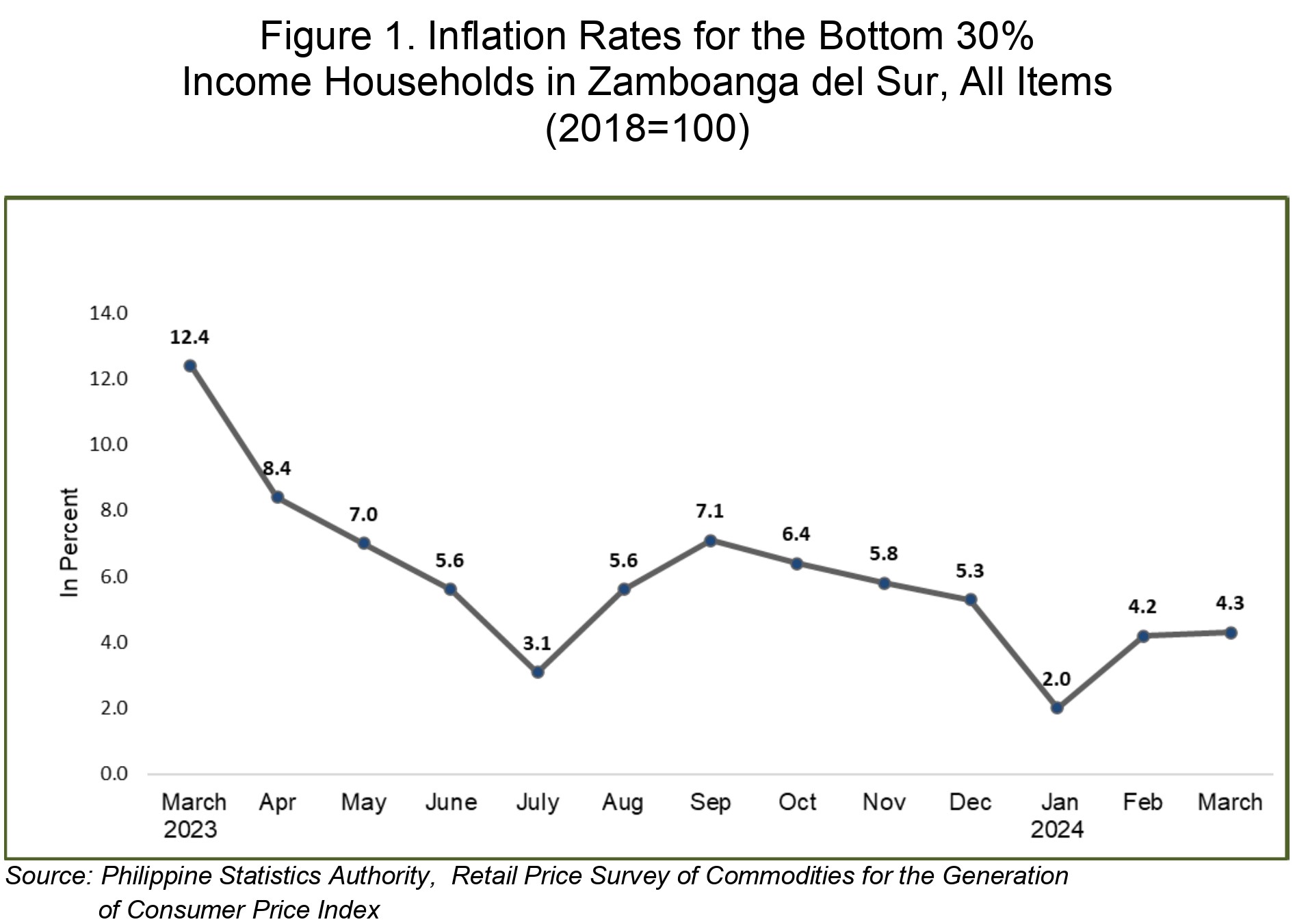
1. Overall Inflation
Zamboanga del Sur’s inflation for the bottom 30% income households increased to 4.3 percent in March 2024 from 4.2 percent in February 2024. In March 2023, inflation rate was posted at 12.4 percent. (Tables A and B, and Figure 1)



1.1 Main Drivers to the Uptrend of the Overall Inflation
The main driver of the upward trend of the overall inflation for this income group in March 2024 was the higher year-on-year growth in the heavily weighted food and non-alcoholic beverages at 6.9 percent from 5.9 percent in the previous month. This was followed by alcoholic beverages and tobacco which posted an annual increase of 11.2 percent from 8.7 percent; and furnishings, household equipment and routine household maintenance at 5.3 percent from 4.4 percent in February 2024.
Higher annual increment was also noted in the index of personal care, and miscellaneous goods and services at 4.6 percent from 4.4 percent in the previous month.
In contrast, six commodity groups registered lower inflation rates during the month:
a. Clothing and footwear, 4.1 percent from 4.5 percent;
b. Housing, water, electricity, gas, and other fuels, -8.9 percent from -5.7 percent;
c. Health, 3.2 percent from 4.1 percent;
d. Transport, -0.7 percent from 1.5 percent;
e. Recreation, sport and culture, 8.4 percent from 8.9 percent; and
f. Restaurants and accommodation services, 3.8 percent from 4.0 percent.
The indices of information and communication, education services and financial services retained their previous month’s annual rates. (Table C)
1.2 Main Contributors to the Overall Inflation
The top three commodity groups contributing to the March 2024 overall inflation for the bottom 30% income households were the following:
a. Food and non-alcoholic beverages with 100.5 percent share or 4.32 percentage points;
b. Alcoholic beverages and tobacco with 5.2 percent share or 0.23 percentage points; and
c. Personal care, and miscellaneous goods and services with 4.3 percent share or 0.19 percentage points.
2.0 Food Inflation

Food inflation for the bottom 30% income households in the province moved at a faster pace of 6.9 percent in March 2024 from 5.8 percent in the previous month.
2.1 Main Drivers to the Upward Trend of Food Inflation
The acceleration of the food inflation in the province was mainly brought about by the slower annual decrease in the vegetables, tubers, plantains, cooking bananas and pulses at 12.8 percent during the month from 21.5 percent annual decrease in February 2024. Also contributing to the uptick is the slower annual decrease in fish and other seafood at 10.4 percent during the month from an annual decrease of 11.2 percent. The annual increase in ready-made food and other food products at 7.9 percent from 4.8 percent in the previous month also contributed to the uptrend.
The inflation rate of milk, other dairy products and eggs also increased to 10.1 percent from 9.1 percent during the month. Moreover, slower annual decline was noted in the index of sugar, confectionery and desserts at 4.6 percent during the month from 6.3 percent annual decline in February 2024.
On the contrary, lower annual growth rates were observed in the indices of cereals and cereal products, which include rice, corn, flour, bread and other bakery products, pasta products, and other cereals at 28.4 percent from 29.9 percent in the previous month. The index of meat and other parts of slaughtered land animals recorded an annual decline of 3.0 percent from an annual decrease of 2.0 percent. (Table D)
2.2 Main Contributors to the Food Inflation
Food inflation contributed 96.2 percent or 4.14 percentage points to the March 2024 overall inflation for this particular income group.
Among the food groups, the main contributors to the food inflation during the month were the following:
a. Cereals and cereal products, which include rice, corn, flour, bread and other bakery products, and other cereals, with 126.3 percent share or 8.72 percentage points;
b. Milk, other dairy products and eggs with 5.7 percent share or 0.40 percentage points; and
c. Fruits and nuts with 3.4 percent share or 0.23 percentage points. (Table D)
DIMNA P. BIENES
(Supervising Statistical Specialist)
Officer-in-Charge
